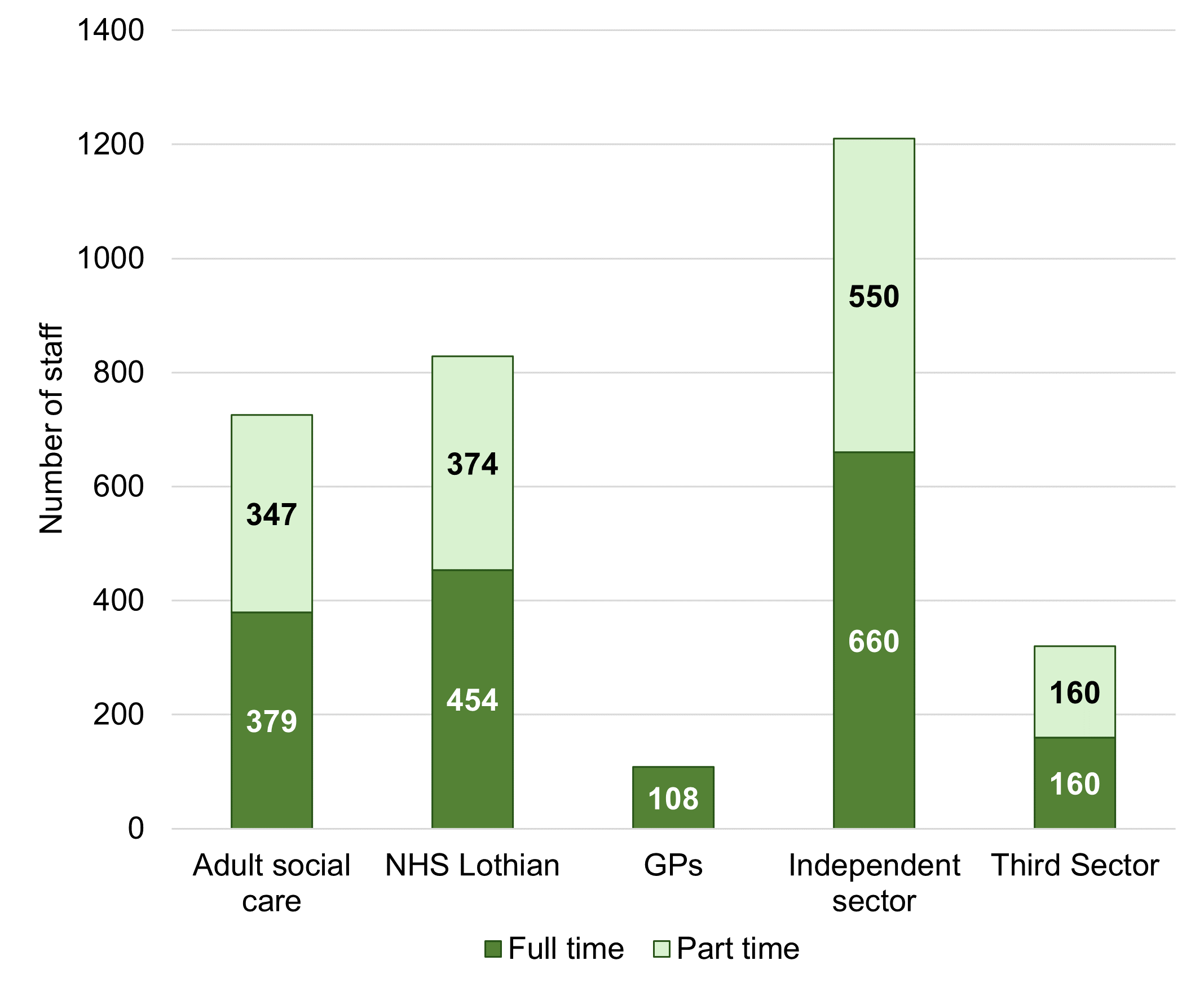Workforce - Data
Impact Assessment
What the data tells us
Midlothian Health and Social Care Partnership is the biggest employer in Midlothian and work alongside the independent sector (private social/healthcare companies) and the third sector (not for profit organisations).
Midlothian’s HSCP workforce includes:
Midlothian Council's Adult Health and Social Care Staff:
- Adult Support Protection Roles
- Administrative Services
- Allied Health Professionals
- Care Roles
- Community Justice Roles
- Justice Roles
- Learning and Development Roles
- Mental Health and Substance Use Roles
- Public Health Roles
- Residential and Non-residential Care
- Social Workers across varying client groups Inc mental health, substance use, Learning Disability, Physical Disability and Older People
- Housing support roles
- Shared lives services
- Community care assistants
- Hospital Inreach
- Laundry and domestic roles
- Handyperson in care homes etc
- Welfare rights roles
- Planning officers for each client group
- Unpaid carers planning officer
- SVQ Assessment centre roles
- Trauma development worker
- Self-directed support roles
NHS Lothian Staff:
Administrative Services
•Allied Health Professionals
- Dietetics
- Occupational Therapy
- Podiatrists
- Physiotherapy
- Palliative End of Life Care
•Medical
- Consultants
- Special Doctors
- Salaried GPs
•Nursing
- Care of the Elderly
- District Nursing
- General Acute Nursing
- Learning Disabilities
- Health Visiting
- Mental Health
- Public Health
- School Nursing
- Specialist Nursing
- Treatment Room Nursing
•Pharmacy
•Support Services
- Transport Services
- Hotel Services
- Local Workforce Supply
81% of the population of Midlothian is economically active compared with 77% across Scotland (Nomis, 2021).
Of the 19% economically inactive within Midlothian: 27% are Retired, 26% are Long Term Sick and 24% are Looking After Family/Home.
Midlothian has a job density of 0.64 jobs per person. This is below the Scotland wide density of 0.81 jobs per person aged 16-24 (Nomis 2021). The top 5 job types by number of jobs within Midlothian are:
- Wholesale and Retail Trade; Repair of Motor Vehicles and Motorcycles (21%)
- Education (12%)
- Construction (11%)
- Human Health and Social Work Activities (11%)
- Manufacturing (9%)
The independent sector is the main provider of care at home for older people providing 3,100 hours of care per week to 370 individuals. Over 200 care workers, across 3 Care at Home teams, provide 2,500 hours of care per week to 310 individuals. For other client groups the voluntary sector tends to be the main provider.
Number of Midlothian HSCP staff by sector in 2022
Data source: Scottish Social Services Workforce Data, Midlothian Council and Public Health Scotland

Over 85% of the workforce (including independent and voluntary sector) is female (2021).
Around 50% of staff are employed part time. This is an increasing trend in several areas including GPs. As more people choose to work less than full time, it is necessary to employ more people to fulfil whole time equivalents.
The Third Sector
The Third Sector plays a significant role in local communities and works alongside health and social care services supporting vulnerable people; providing services and promoting community cohesion. Groups range in size and formality. The Midlothian Profile shows that there are at least 700 voluntary sector groups and organisations including more than 50 uniformed youth groups e.g., Brownies, Guides, Cubs, and Scouts; and small informal local or interest groups, such as art clubs and walking groups.
There are approximately 270 charities based in Midlothian registered with the Office of the Scottish Charity Register (OSCR). It is difficult to know the exact figure because of the way data is collected and displayed by OSCR (e.g., many Edinburgh only organisations are displayed as Midlothian, and not all charities that are based in Midlothian are registered at a Midlothian postcode). In addition, many of the larger charities that work in Midlothian are based elsewhere (e.g., Edinburgh), and work in more than one local authority area.
Voluntary organisations, charities, community groups, and social enterprises are supported by the Midlothian Third Sector Interface which consists of Midlothian Voluntary Action (MVA); the Volunteer Centre Midlothian; and SEAM (Social Enterprise Alliance Midlothian)
There are 74 social enterprises active in Midlothian (The Social Enterprise in Scotland 2021 Census). This includes development trusts, housing associations, childcare organisations, and other income-generating organisations.
It is difficult to get detailed figures for staffing levels. Scottish Social Services Council (SSSC) publishes headcount figures for people employed in the Social Services sector. The latest figures available are for 2021 and show that of the 3,320 people employed in the social services sector in Midlothian, 700 are in the voluntary sector (approx. 21%).
Volunteering
A Citizen's Panel survey in 2017/18 showed that around 31% of adults are involved in formal volunteering. This is an increase on the previous estimate, representing about 27,000 people and is above the national average of 28%. In addition to this are those who volunteer informally. Volunteer Midlothian supports local volunteers and connects volunteers to opportunities in the community. To ensure that good quality volunteering opportunities are available for everyone, a Volunteering Charter for Midlothian has been drawn up with the aim of raising standards within volunteering.
Page updated October 2024
